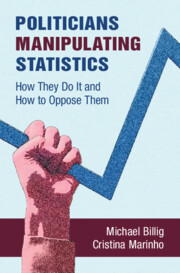Refine search
Actions for selected content:
70 results

Politicians Manipulating Statistics
- How They Do It and How to Oppose Them
-
- Published online:
- 31 May 2025
- Print publication:
- 03 April 2025
What about elite manipulation in deliberative mini-publics? Examining threats and resilience in the Ostbelgien model
-
- Journal:
- European Political Science Review / Volume 17 / Issue 3 / August 2025
- Published online by Cambridge University Press:
- 13 May 2025, pp. 415-431
-
- Article
-
- You have access
- Open access
- HTML
- Export citation
1 - Persuasion and Influence in Linguistic Research
- from I - (Re)framing Persuasion
-
-
- Book:
- Manipulation, Influence and Deception
- Published online:
- 10 June 2025
- Print publication:
- 24 April 2025, pp 3-18
-
- Chapter
- Export citation
Chapter 6 - On Manipulation in Politics
- from Part II - The Ethics
-
- Book:
- The Concept and Ethics of Manipulation
- Published online:
- 10 April 2025
- Print publication:
- 17 April 2025, pp 197-222
-
- Chapter
- Export citation
Chapter 4 - The Moral Status of Manipulation
- from Part II - The Ethics
-
- Book:
- The Concept and Ethics of Manipulation
- Published online:
- 10 April 2025
- Print publication:
- 17 April 2025, pp 119-158
-
- Chapter
- Export citation
Chapter 5 - Manipulation and Respect for Persons
- from Part II - The Ethics
-
- Book:
- The Concept and Ethics of Manipulation
- Published online:
- 10 April 2025
- Print publication:
- 17 April 2025, pp 159-196
-
- Chapter
- Export citation
Chapter 1 - An Elusive Concept
- from Part I - The Concept
-
- Book:
- The Concept and Ethics of Manipulation
- Published online:
- 10 April 2025
- Print publication:
- 17 April 2025, pp 3-41
-
- Chapter
- Export citation
Chapter 3 - Manipulation: The Anatomy
- from Part I - The Concept
-
- Book:
- The Concept and Ethics of Manipulation
- Published online:
- 10 April 2025
- Print publication:
- 17 April 2025, pp 79-116
-
- Chapter
- Export citation
Chapter 2 - Manipulation as Conceptual Metaphor
- from Part I - The Concept
-
- Book:
- The Concept and Ethics of Manipulation
- Published online:
- 10 April 2025
- Print publication:
- 17 April 2025, pp 42-78
-
- Chapter
- Export citation
Chapter 1 - Introduction
-
- Book:
- Politicians Manipulating Statistics
- Published online:
- 31 May 2025
- Print publication:
- 03 April 2025, pp 1-9
-
- Chapter
-
- You have access
- HTML
- Export citation
Pricing accuracy, liquidity and trader behavior with closing price manipulation
-
- Journal:
- Experimental Economics / Volume 14 / Issue 1 / March 2011
- Published online by Cambridge University Press:
- 14 March 2025, pp. 110-131
-
- Article
- Export citation
There is no fresh air: A problem with the concept of echo chambers
-
- Journal:
- Episteme , First View
- Published online by Cambridge University Press:
- 04 March 2025, pp. 1-19
-
- Article
-
- You have access
- Open access
- HTML
- Export citation
Introduction: Populists, Demagogues, Language
-
- Book:
- Brexitspeak
- Published online:
- 22 November 2024
- Print publication:
- 05 December 2024, pp 1-21
-
- Chapter
-
- You have access
- HTML
- Export citation
4 - Experiments and Causality
- from Part I - The Philosophy and Methodology of Experimentation in Sociology
-
- Book:
- Experimental Sociology
- Published online:
- 23 November 2024
- Print publication:
- 21 November 2024, pp 40-51
-
- Chapter
- Export citation
1 - Introduction
-
- Book:
- Experimental Sociology
- Published online:
- 23 November 2024
- Print publication:
- 21 November 2024, pp 1-10
-
- Chapter
- Export citation
6 - Laboratory Experiments
- from Part II - The Practice of Experimentation in Sociology
-
- Book:
- Experimental Sociology
- Published online:
- 23 November 2024
- Print publication:
- 21 November 2024, pp 69-80
-
- Chapter
- Export citation
Mediation: Common Practices and Ethical Boundaries
-
- Journal:
- Journal of Law, Medicine & Ethics / Volume 52 / Issue 2 / Summer 2024
- Published online by Cambridge University Press:
- 22 October 2024, pp. 324-332
- Print publication:
- Summer 2024
-
- Article
- Export citation
Transparency and nudging: an overview and methodological critique of empirical investigations
-
- Journal:
- Behavioural Public Policy / Volume 8 / Issue 4 / October 2024
- Published online by Cambridge University Press:
- 13 March 2024, pp. 807-817
-
- Article
-
- You have access
- Open access
- HTML
- Export citation
Manipulation in politics and public policy
-
- Journal:
- Economics & Philosophy / Volume 40 / Issue 3 / November 2024
- Published online by Cambridge University Press:
- 06 March 2024, pp. 685-710
-
- Article
-
- You have access
- Open access
- HTML
- Export citation
